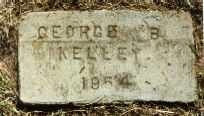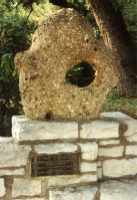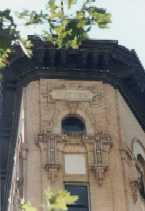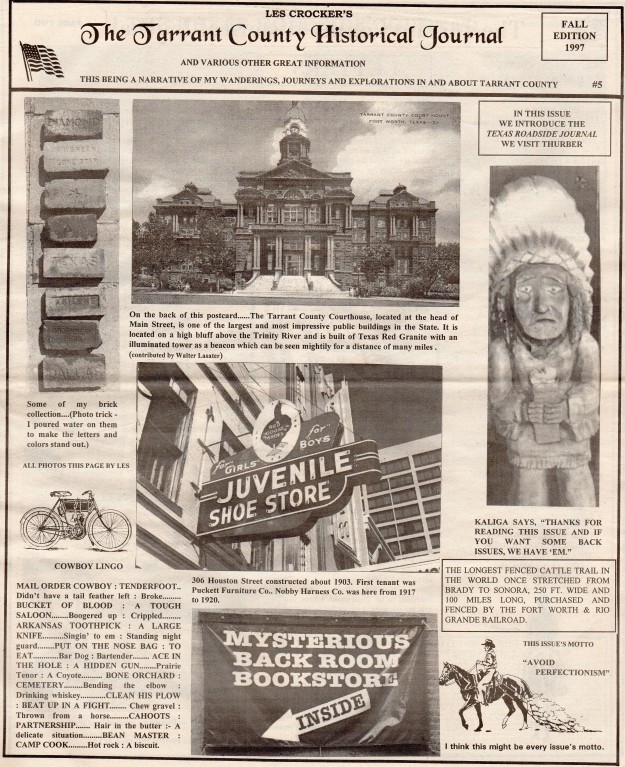The following is just a sample of the pictures and articles in the 20 pages of issue #5.
Cowboy Lingo
Mail Order Cowboy = Tenderfoot
Didn’t have a tail feather left = Broke
Bucket of Blood = A tough saloon
Boogered up = Crippled
Arkansas Toothpick = A large knife
Singin’ to ’em = Standing night guard
Put on the nose bag = To eat
Bar Dog = Bartender
Ace in the hole = A hidden gun
Prairie Tenor = A Coyote
Bone Orchard = Cemetery
Bending the elbow = Drinking whiskey
Clean his plow = Beat up in a fight
Chew gravel = Thrown from a horse
Cahoots = Partnership
Hair in the butter = A
delicate situation
Bean Master = Camp cook
Hot Rock = A biscuit
Overheard at a Northside Café:
A cowboy was complaining to his waiter that his steak wasn’t cooked enough, “Waiter, do you call this steak well done? I’ve seen cows hurt worse than this get well.”
Machine Gun Kelly
Notorious Public Enemy #1 George “Machine Gun” Kelly is buried in the Cottondale Cemetery in Wise county. Kathrine Kelly bought George’s machine gun in a Fort Worth pawn shop. That’s how he got his nickname. Sometime in the early 1930’s the FBI added Machine Gun Kelly to it’s Most Wanted List. What made the Lellys famous was the kidnapping of an Oklahoma city oilman Charles F. Urshel on July 22nd, 1933. They demanded and received a ransom of $200,000. Urshel was let go ten days later unharmed. Less than a month later the FBI agents caught up with them and surrounded them. Outnumbered, Kelly quickly shouted to his wife, “Don’t shoot! It’s the G-Men.” That’s how they acquired the nickname “G-Men”. Kelly was given a life sentence and sent to Alcatraz. Later he was transferred to Leavenworth in Kansas. Katherine Kelly was sent to the federal reformatory for Women at Alderson, West Virginia. Later she was transferred to a prison in Cincinnati. She was released  in 1958 and it is not known where she ended up. Machine Gun Kelly died of a heart attack July 17, 1954. He was 58 years old. To find his simple marker: at the Cottendale Cemetery front gate, walk down the middle walkway just over half way down on your right. It’s close to the walkway.
in 1958 and it is not known where she ended up. Machine Gun Kelly died of a heart attack July 17, 1954. He was 58 years old. To find his simple marker: at the Cottendale Cemetery front gate, walk down the middle walkway just over half way down on your right. It’s close to the walkway.
Thistle Hill
 Next I drove to the 1500 block of Pennsylvania Street. This is Thistle Hill. Thistle Hill was built in 1903 for Electra Waggoner Wharton. She lived there with her husband A.B. Wharton. In 1910 it was purchased by Winfield Scott, a cattle baron, for $90,000. He then spent $100,000 in furniture and landscaping. The Mansion has eighteen rooms including such as a library, drawing room, dining room, billiard room, morning room, kitchen, dressing rooms and bedrooms.
Next I drove to the 1500 block of Pennsylvania Street. This is Thistle Hill. Thistle Hill was built in 1903 for Electra Waggoner Wharton. She lived there with her husband A.B. Wharton. In 1910 it was purchased by Winfield Scott, a cattle baron, for $90,000. He then spent $100,000 in furniture and landscaping. The Mansion has eighteen rooms including such as a library, drawing room, dining room, billiard room, morning room, kitchen, dressing rooms and bedrooms.
How did Fort Worth get the Nickname “Panther City”?
It seems that around 1876 a Dallas newspaper was poking fun at Fort Worth. They said that Fort Worth was such a sleepy little town that a panther could sleep undisturbed in its streets. Fort Worth residents took this to be a compliment and so Fort Worth adopted the nickname “Panther City”. I checked the Fort Worth phone book’s business pages and found two businesses named after Panther City and two named after Panther.
Interview With An Old Tree
This tree is on the 2nd Street hill where bulldozers have torn down the last remaining old house in this area to make way for the new…
Les: “Hello old tree.”
Tree: “Who are you calling old?”
Les: “Whoops, sorry. But, just how old are you?”
Tree: “I don’t know. They would have to cut me down and count my rings, you know.”
Les: “Yes, I know.”
Tree: “That is why I have this yellow ribbon around me, to remind them not to cut me down.”
Les: “Well, I’m glad to see it works.”
Tree: “Me too.”
Les: “Do you have any idea how long you’ve been hanging around the neighborhood?”
Tree: “Well, I was here before they built the first batch of houses around here.”
Les: “It looks like they are about to build some new houses.”
Tree: “Yes, I’m glad. I miss the noise and commotion of kids and families. It’s been very quiet around here the last quarter century or so. HEY, tell that bulldozer he got mighty close that time. Anyway, where was I?”
Les: “We were talking about the new families that will be moving in.”
Tree: “Oh yes. One thing I’ll miss when the new houses are built is that they will all have refrigerators.”
Les: “What does that have to do with anything?”
Tree: “Well, you remember back when the iceman came around delivering blocks of ice?”
Les:”Just barely.”
Tree: “Well, I just loved it when the iceman would chip ice and some of it would fall onto my roots. Boy, was that cool. But most of the time the kids would be waiting to pick the ice up.”
Les: “You know, my grandfather was an iceman for awhile. Did you know him? His name was John Roy Smith, Sr.”
Tree: “Sounds familiar, but I can’t remember much you know.”
Les: “So you say. Well, I gotta go. I have to go write this story, old tree.”
Tree: “Who you calling OLD?”
 This stone is on the grounds of the Van Zandt Cottage. It was a road building tool used by the pioneer Louis Wetmore. He was a Confederate Soldier and was killed in the Civil War. The rock has a hole near the center and was dragged by oxen to smooth the roads near his farm south of Fort Worth.
This stone is on the grounds of the Van Zandt Cottage. It was a road building tool used by the pioneer Louis Wetmore. He was a Confederate Soldier and was killed in the Civil War. The rock has a hole near the center and was dragged by oxen to smooth the roads near his farm south of Fort Worth.
 This is the seventh floor of the Flat Iron Building at 1000 Houston Street. In the early 1900’s it was the tallest building in North Texas. It was built for $70,893 in 1907 by Dr. Bacon Saunders. He had seen the 1902 Flat Iron Building in New York and decided that’s what he wanted built on his little triangle shaped lot. The building has been vacant since the 1970’s. At one time about 25 years ago it was for sale. They wanted $75,000 at that time. Wish I had bought it.
This is the seventh floor of the Flat Iron Building at 1000 Houston Street. In the early 1900’s it was the tallest building in North Texas. It was built for $70,893 in 1907 by Dr. Bacon Saunders. He had seen the 1902 Flat Iron Building in New York and decided that’s what he wanted built on his little triangle shaped lot. The building has been vacant since the 1970’s. At one time about 25 years ago it was for sale. They wanted $75,000 at that time. Wish I had bought it.
The little boy knelt down beside his bed for his evening prayer. He thanked God for his blessings, just as he had been taught. Then the boy asked God to bless his parents, brothers, and sisters, pets, relatives, friends, and all the policemen in the world. He ended with a firm amen and started to jump into bed. But he remembered something he had failed to add and knelt down again. “By the way, God”, he said, “You probably won’t hear from me again, my Dad got transferred and we’re moving to Texas.”
From the Roadside Journal
In March 1897 the Green and Hunter Brick Company was organized. The company had 18 kilns in operation and at its peak, over 80,000 bricks a day were produced. The company made thirty-five different bricks.

Thurber
On Interstate 20 about 70 miles West of Fort Worth. Thurber was a booming coal mining town for about 30 years. It was on the main shipping line of the T & P Railroad. When the railroads converted their locomotives into oil burners, the town started its slide down into oblivion. At one time there were more than 10,000 people in the company town. When the company decided it was of no more use, they demolished it. The company ordered everything on the surface to be removed or torn down. A few things were spared, the old brick smokestack for the power and ice plant, W. K. Gordon’s home, the home of the assistant superintendent, the drugstore, and the store building. Although the coal mines were closed in 1921 the brick plant was kept operating through the 1920s and finally closed around 1930.

